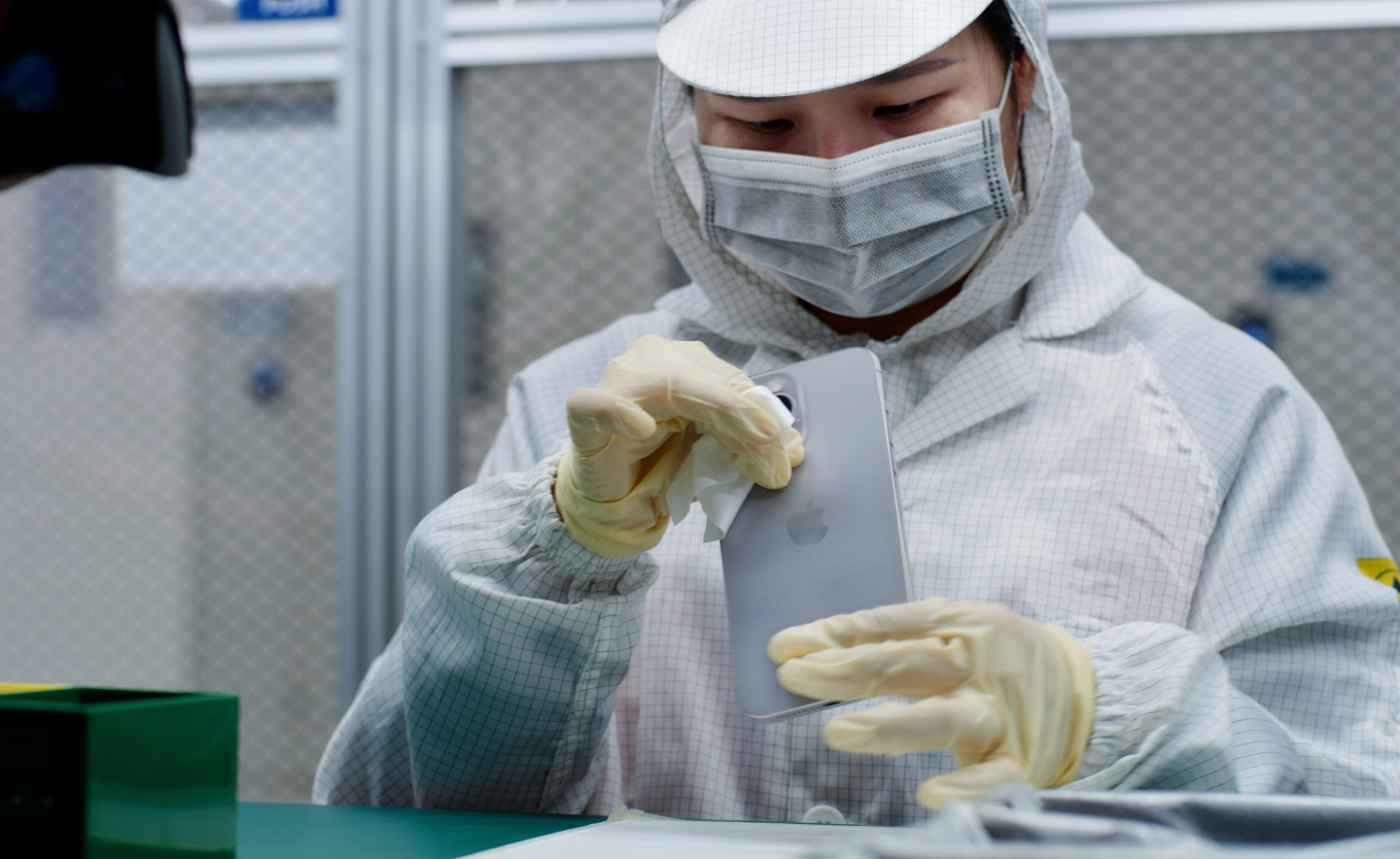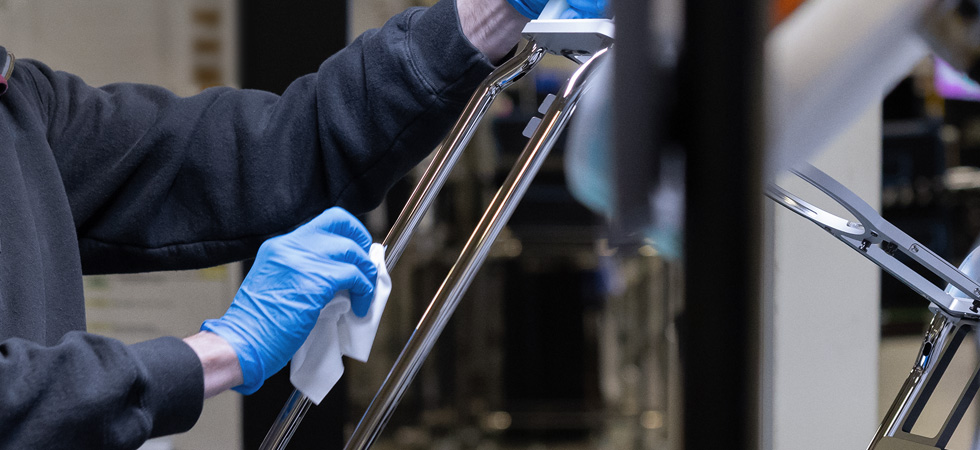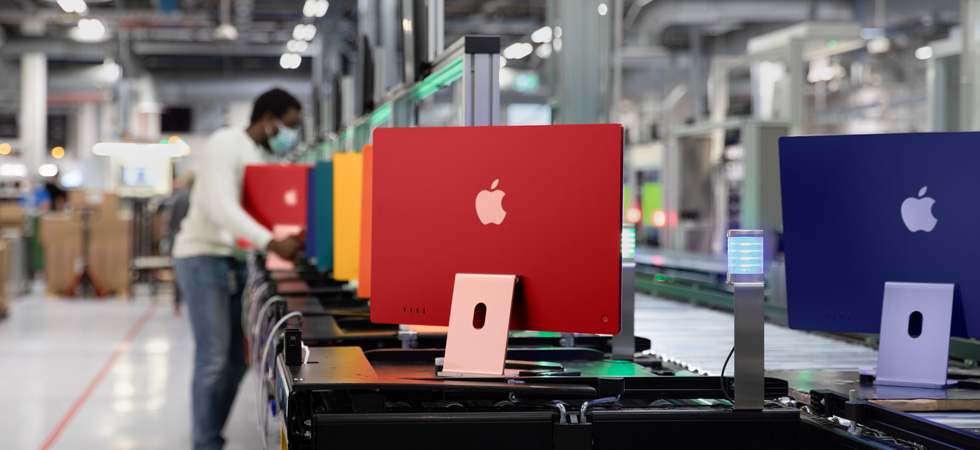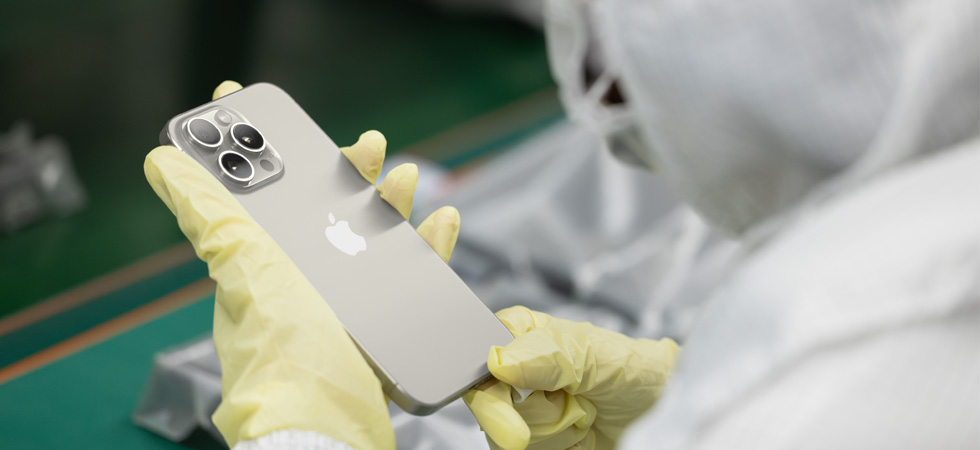Supply Chain Innovation (original) (raw)
Designed by Apple in California. Made by people everywhere.


Business can and should be a force for good. We uphold our values everywhere we operate, supporting the people and communities across our supply chain, and working to protect the planet we all share.
A global supply chain.
A global supply chain.
Studio Display assembly, China mainland
Apple products are made all over the world.
Thousands of businesses and millions of people in more than 50 countries and regions are part of our supply chain, contributing their skills, talents, and efforts to help build, deliver, repair, and recycle our products.
Our suppliers are required to meet the strict standards of the Apple Supplier Code of Conduct, no matter where they operate or what type of goods, services, or labor they provide to Apple.
Counterclockwise from top: Apple Watch assembly, Vietnam; Apple Watch band manufacturing, Japan; Mac Pro assembly, United States
We listen. And act.
We listen. And act.
Component manufacturing, Switzerland

Component manufacturing, Switzerland
We listen. And act.
We encourage everyone across our supply chain to share feedback. And we’re focused on ways to amplify their voices. We interview and survey hundreds of thousands of supplier employees, and provide hotlines so they can anonymously raise concerns directly to Apple. We use this feedback to support our suppliers in strengthening their operations and providing the best possible experience for their employees.
We investigate reported concerns quickly, with Apple experts typically arriving onsite within 24 to 48 hours. Apple has zero tolerance for retaliation, and any supplier found to have retaliated against an employee for raising a concern faces immediate consequences, up to and including termination of their business with Apple. We require our suppliers to promptly address any issues, and we regularly check on their progress until we confirm that all necessary actions have been taken.
If suppliers are unwilling or unable to correct any issues, they risk removal from our supply chain. Since 2009, we have removed 25 manufacturing supplier facilities and 231 smelters, refiners, and manufacturers of materials from our supply chain for failing to meet our standards.
Counterclockwise from top: Logistics, United States; Apple Watch assembly, Vietnam; iPhone assembly, China mainland
- 581K+
supplier employees directly engaged by Apple about their workplace experience in 2023 - 7.1K+
improvements made to supplier workplaces based on employee feedback in 2023, mostly focused on services like transportation and dining - 830K+
people at 35 supplier sites reached by our hotline awareness campaign, which provides knowledge on how to raise workplace concerns - 35K+
supplier employees contacted following interviews to ensure that they didn’t experience retaliation as a result of their participation
Labor and human rights at the foundation.
Labor and human rights at the foundation.
Apple Watch assembly, Vietnam

Apple Watch assembly, Vietnam
Labor and human rights at the foundation.
Everyone has the right to work in a safe and healthy environment where they’re treated with respect and dignity. We uphold these rights with every decision we make, including the suppliers we choose to work with, the materials we select for our products, and the processes and equipment we use to make them. We work closely with our suppliers to uphold the highest standards of labor and human rights everywhere our business reaches.
Our standards apply globally, regardless of where people live or work or which job they do. We require our suppliers to educate their employees on their workplace rights, including how to share feedback if their rights aren’t being respected. With the help of experts, nonprofit organizations, government agencies, and workers themselves, we consistently strengthen our requirements and programs to make sure they continue to meet the needs of people across our supply chain.
From top to bottom: Component manufacturing, India; Studio Display assembly, China mainland
- 28M+
supplier employees trained on their workplace rights since 2008 - 1.4M+
supplier employees’ working hours reviewed weekly to verify compliance with our standards - 4.6M+
education and training sessions delivered through the Apple Supplier Employee Development Fund (SEDF)
Dedicated to continuous improvement.
Dedicated to continuous improvement.
Product personalization, United States

Product personalization, United States
Dedicated to continuous improvement.
Before a prospective supplier enters our supply chain, we assess their ability to meet our standards and identify areas for improvement. We hold suppliers accountable for our strict standards through regular, rigorous onsite assessments. Conducted by independent third-party auditors, these assessments look at every detail of a supplier’s operations through worker and management interviews, detailed site walkthroughs, and thorough reviews of documentation.
Suppliers must fix any violation of our standards under the supervision of Apple experts and take steps to prevent the issues from happening again. Any suppliers that are unable or unwilling to improve their operations to meet our requirements risk removal from our supply chain.
We also support our suppliers’ continual learning and improvement by having Apple experts share knowledge, advise on best practices, and design learning plans customized to the needs of each site.
Clockwise from top left: HomePod assembly, Vietnam; Component manufacturing, Germany; Fiber-based packaging production, Austria
- 893
assessments of supplier facilities conducted in 2023, including 203 unannounced visits - 11%
of prospective suppliers prevented from entering our supply chain since 2020 for being unable or unwilling to meet our requirements
The strongest standards in hiring.
The strongest standards in hiring.
Mac Pro assembly, United States

Mac Pro assembly, United States
The strongest standards in hiring.
Apple has no tolerance for forced labor. Our policies that prevent forced labor apply globally, regardless of a person’s job, location, or how they were hired. We require that job recruitment processes be free and fair, prohibiting practices such as charging fees to secure a job — even where it’s allowed by law. We’ve partnered with the International Organization for Migration (IOM), a United Nations agency, to create easy-to-use tools that help suppliers recruit people ethically and with respect for their human rights.
Our work to prevent forced labor extends throughout the employment journey, and we verify that suppliers are meeting our standards every time we engage with them, including during assessments.
Learn more about our efforts to prevent forced labor (PDF)
- 0
instances found where people were forced to work in our supply chain in 2023 - 800+
people trained on the industry-leading tools in the Apple Responsible Labor Recruitment Due Diligence Toolkit in 2023 - $34.5M+
in recruitment fees paid back by suppliers to more than 37,700 employees since 2008 due to Apple’s zero-fees policy
Skills that open doors.
Skills that open doors.
Component manufacturing, Switzerland

Component manufacturing, Switzerland
Skills that open doors.
Through the Apple Education Hub, people across our supply chain are able to access technical education and resources on topics such as personal development, leadership, computer science, coding, robotics, recycling, and advanced manufacturing. These programs enrich supplier employees’ workplace experiences and provide the skills needed to pursue opportunities in highly technical fields. For example, graduates of our Swift coding program have launched apps on the App Store, meeting the high bar required for publication.
We partner with leading experts such as the Council for Adult and Experiential Learning (CAEL) in the United States, Zhejiang University in China mainland, and St. John’s Medical College in India to ensure that our programs are innovative, meaningful, and connected to relevant opportunities in local job markets.
Clockwise from top: Component manufacturing, Japan; Component manufacturing, India; Mac Pro assembly, United States
- 1.5K
technical or management positions attained by graduates of our education programs - 39K+
supplier employees who have graduated from our Swift coding program since 2017
The Supplier Employee Development Fund.
The Supplier Employee Development Fund.
Apple Education Hub, China mainland

Apple Education Hub, China mainland
The Supplier Employee Development Fund.
Education is a powerful equalizing force, and we are committed to providing opportunities for the people in our supply chain to learn and grow. In 2022, we announced a $50 million Supplier Employee Development Fund (SEDF) to further invest in people in our supply chain. Through the fund’s Apple Education Hub, we’re expanding access to educational opportunities for supplier employees and their surrounding communities.
In partnership with local academic institutions and non-governmental organizations (NGOs), the Apple Education Hub helps supplier employees develop the skills necessary to pursue new opportunities in our supply chain, as well as better manage their health and well-being.
From top to bottom: Component manufacturing, United States; Retail janitorial services, United States
- 160K+
supplier employee participants in learning and development opportunities through the Apple Education Hub in 2023 - 7M+
supplier employee participants in our education programs since 2008
Health starts with knowledge.
Health starts with knowledge.
Education programs, India

Education programs, India
Health starts with knowledge.
We’re committed to cultivating a supply chain where people can thrive — inside and outside work. This means providing the people in our supply chain with the tools needed to focus on their physical and mental health. Since 2017, millions of supplier employees have benefited from training on essential topics such as nutrition, reproductive health, early disease detection, and mental health. These programs are tailored to meet the needs of local supplier employee populations, equipping them with important knowledge and skills to take control of their own health, which they can then share with their communities to multiply the impact.
Counterclockwise from top: Health and wellness education, Vietnam; Health and wellness education, India; iPhone assembly, China mainland
- 4.5M+
people reached by our health and wellness programs since 2017 - 6K+
participants in our mental well-being programs in 2023
Advanced. Manufacturing.
Advanced. Manufacturing.
Component manufacturing, United States

Component manufacturing, United States
Advanced. Manufacturing.
As we continue to drive innovation in our products, the machines used to build them must also advance. That’s why we’re always reviewing and strengthening our machine safety programs to help keep the people who operate manufacturing equipment safe on the job. We require suppliers to design safer equipment from the start and to conduct regular trainings on topics such as the use of safety devices, inspection basics, automation safety, and hazards associated with moving parts. We also require suppliers to regularly inspect equipment and safety procedures to confirm that machines remain in safe working condition and that the rules put in place to keep people safe are being enforced and followed. If we do find issues, we work with suppliers to correct them and prevent them from happening again.
Counterclockwise from top: Component manufacturing, Japan; Component manufacturing, China mainland; Component manufacturing, Germany
- 750+
supplier sites enrolled in our new enhanced machine safety training in 2023 - 2.6K+
machines inspected for safety risks at 112 key supplier sites around the world in 2023
A culture of safety.
A culture of safety.
iMac assembly, Ireland

iMac assembly, Ireland
A culture of safety.
Everyone has the right to be safe at work, and we work hard to verify that the materials, machines, and processes used to make our products safeguard the health and safety of the people in our supply chain. We consistently update our industry-leading health and safety standards and confirm that our suppliers meet those standards through regular inspections. We also partner with our suppliers to build a workplace culture that puts health and safety at the forefront every day, including by offering training materials and providing ways for employees to speak up if they identify opportunities to improve safety practices.
Counterclockwise from top: Fiber-based packaging production, Austria; Mac Pro assembly, United States; Component manufacturing, Germany
- 850+
supplier sites participated in safety training in 2023 - 123
Facility Readiness Assessments conducted before manufacturing began in 2023
Leading the way on smarter chemistry.
Leading the way on smarter chemistry.
iPad assembly, Vietnam

iPad assembly, Vietnam
Leading the way on smarter chemistry.
Keeping workers and customers safe is a top priority that guides the decisions we make about the materials we use in our products. We require our suppliers to follow our industry-leading chemical safety standards to make sure that employees, communities, and the environment are protected against chemical hazards. This includes working together to use safer materials in our products and manufacturing processes, such as in the cleaners used during product assembly. By collaborating with leading experts and nonprofit organizations, we’re accelerating the adoption of safer chemicals across the electronics industry, fostering safer working conditions for people far beyond our own supply chain.
Counterclockwise from top: MacBook Pro assembly, China mainland; iPhone assembly, China mainland; Supplier water treatment facility, United States
- 1K
suppliers reported data on the chemicals used in their facilities in 2023 - 66
new safer cleaners approved for use in our supply chain in 2023, with a total of 175 approved cleaners deployed to our suppliers since 2020
A carbon neutral supply chain by 2030.
A carbon neutral supply chain by 2030.
Apple Watch assembly, Vietnam

Apple Watch assembly, Vietnam
A carbon neutral supply chain by 2030.
Apple’s worldwide corporate operations have been carbon neutral since 2020, and we’ve set a goal to become carbon neutral across our entire supply chain, including the lifetime use of our products, by 2030.
Reaching our Apple 2030 goal means we first need to continue reducing the carbon emissions from our manufacturing processes. To make this happen, we’re designing our products to be less carbon-intensive, increasing our use of recycled and renewable materials, and transitioning our entire supply chain to 100 percent renewable energy. We’ll then use carbon removal to address the small amount of remaining emissions, starting with high-quality nature-based solutions, like those in Apple’s Restore Fund.
We’ve also called on our suppliers to decarbonize their Apple production by 2030, and we’re helping them get there through targeted programs and training that aim to improve their energy efficiency and identify sources of high-quality renewable energy.
Counterclockwise from top: Supplier solar array installation, Switzerland; Apple Watch band manufacturing, Japan; Apple Watch assembly, Vietnam
- 100%
of Apple suppliers expected to be carbon neutral for their Apple production by 2030 - 16
gigawatts of renewable energy operational in the Apple supply chain
Environmental rights are human rights.
Environmental rights are human rights.
Responsibly managed forest, Austria

Responsibly managed forest, Austria
Environmental rights are human rights.
The global impacts of climate change are becoming more apparent by the day. Our approach to protecting the planet considers not only the environmental implications of every decision we make, but also the impact of those decisions on people, particularly those living and working in communities disproportionately affected by climate change. That’s why we consider our supply chain in the context of the local communities where our suppliers operate.
Low-income and historically marginalized communities too often bear the brunt of the effects of climate change. As part of our Racial Equity and Justice Initiative (REJI), we created the Impact Accelerator for Black-, Latinx-, and Indigenous-owned businesses focused on environmental solutions. The Impact Accelerator is just one way we’re helping ensure that those most affected by environmental challenges are also helping design solutions that dismantle the systemic barriers to addressing them.
From top to bottom: Supplier solar array installation, Germany; Supplier water treatment facility, United States
- 40+
Black-, Latinx-, and Indigenous-owned businesses participated in the Impact Accelerator since 2020
A zero waste mindset.
A zero waste mindset.
iPhone assembly, China mainland

iPhone assembly, China mainland
A zero waste mindset.
We’re dedicated to minimizing our resource use and waste as we build our products. We require our suppliers to avoid sending waste to landfills by implementing recycling and reuse programs and developing innovative materials and recycling strategies. Today, all established final assembly sites for major Apple products are Zero Waste Certified.
Water is a critical resource shared by people and ecosystems around the world, and we’re working to protect it for future generations. Through our Clean Water Program, we’re helping suppliers reduce their water usage, promote water recycling, and prevent water pollution. Since the launch of this program in 2015, 20 of our suppliers’ facilities have achieved certification through the Alliance for Water Stewardship (AWS), the world’s leading water stewardship organization. Earning this certification requires suppliers to adopt industry-leading water conservation and stewardship practices while also engaging with their community to protect resources across their local water basin.
From top to bottom: Apple Watch band manufacturing, Japan; HomePod assembly, Vietnam
- 490K+
metric tons of waste diverted from landfills by Apple suppliers in 2023 - 76B+
gallons of freshwater saved through Apple’s Clean Water Program since 2013
Our journey to 100% recycled and renewable.
Our journey to 100% recycled and renewable.
Materials recovered by Daisy, Apple’s iPhone disassembly robot, United States

Materials recovered by Daisy, Apple’s iPhone disassembly robot, United States
Our journey to 100% recycled and renewable.
Our goal is to one day build our products using only recycled and renewable materials and eliminate our reliance on mining. Each year, we move closer to that goal, with more components being made with 100 percent recycled or renewable materials. Effectively disassembling and recycling our products after their use is also a key part of our work to support a circular economy. These processes help recover valuable materials that can be used again, making the best use of limited resources and enabling us to design and build the next generation of devices to be even better for people and the planet. That’s why we help our suppliers efficiently and safely recycle our products, by providing Recycler Guides and conducting assessments to verify that they’re meeting our standards.
We maintain strict standards for the responsible sourcing of materials — whether primary or recycled. Since Apple doesn’t directly purchase or procure primary materials, we work closely with our suppliers to uphold these standards and work with partners to improve conditions in and around mining communities.
Clockwise from top: Daisy, Apple’s iPhone disassembly robot, United States; Supplier hydroelectric energy facility, Austria; Recycling, Singapore
- 100%
responsibly sourced key materials in batteries, whether primary or recycled - 100%
recycled cobalt targeted to be used in all Apple-designed batteries by 2025* - 100%
recycled rare earth elements targeted to be used in all magnets across Apple products by 2025
![]()
Read our 2024 reports to learn more about our dedication to people and the planet.
Component manufacturing, India